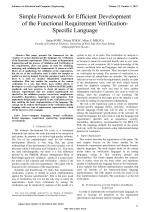| 3/2021 - 2 |
Simple Framework for Efficient Development of the Functional Requirement Verification-specific LanguagePOPIC, S. |
| Extra paper information in |
| Click to see author's profile in |
| Download PDF |
Author keywords
computer languages, formal verification, formal languages, requirement engineering, programming environments
References keywords
language(14), software(12), requirements(12), testing(8), specific(8), domain(8), systems(7), verification(6), formal(6), controlled(6)
Blue keywords are present in both the references section and the paper title.
About this article
Date of Publication: 2021-08-31
Volume 21, Issue 3, Year 2021, On page(s): 11 - 20
ISSN: 1582-7445, e-ISSN: 1844-7600
Digital Object Identifier: 10.4316/AECE.2021.03002
Web of Science Accession Number: 000691632000002
SCOPUS ID: 85115213462
Abstract
This paper presents the framework for the creation of various domain-specific languages for verification of the functional requirements. When it comes to Requirement Engineering and the process of Validation and Verification of the requirements, there are plenty of tools for modeling, analyzing, and validating the requirements. It comes as a full-blown set of applications for validation of the requirements. But the set of the verification tools is either too complex or usable in a narrow domain. From the customers' point of view, there is a need for another independent requirement verification. This tool enables the creation of the custom verification in a way that allows users (either clients or developers) to verify requirements. It follows the IEEE guides, standards, and best practices to check all aspects of the software requirements that are neither implemented nor checked by the validation process: correctness, completeness, traceability, dependency, importance, and uniqueness. Tool implements design patterns specific to the verification process, thus enabling the faster implementation of the language. The concept can be used for development of the verification-specific language with any type of requirement representation, which will be shown by a few examples. |
| References | | | Cited By |
Web of Science® Times Cited: 0
View record in Web of Science® [View]
View Related Records® [View]
Updated 2 weeks, 5 days ago
SCOPUS® Times Cited: 1
View record in SCOPUS® [Free preview]
View citations in SCOPUS® [Free preview]
[1] Constructing a Software Requirements Tool Based on the Reusability Attribute, Alsarraj Gh., Rasha, Altaie, Atica M., Hani Ahmed, Abdullah, IEEE Access, ISSN 2169-3536, Issue , 2024.
Digital Object Identifier: 10.1109/ACCESS.2024.3402144 [CrossRef]
Disclaimer: All information displayed above was retrieved by using remote connections to respective databases. For the best user experience, we update all data by using background processes, and use caches in order to reduce the load on the servers we retrieve the information from. As we have no control on the availability of the database servers and sometimes the Internet connectivity may be affected, we do not guarantee the information is correct or complete. For the most accurate data, please always consult the database sites directly. Some external links require authentication or an institutional subscription.
Web of Science® is a registered trademark of Clarivate Analytics, Scopus® is a registered trademark of Elsevier B.V., other product names, company names, brand names, trademarks and logos are the property of their respective owners.
Faculty of Electrical Engineering and Computer Science
Stefan cel Mare University of Suceava, Romania
All rights reserved: Advances in Electrical and Computer Engineering is a registered trademark of the Stefan cel Mare University of Suceava. No part of this publication may be reproduced, stored in a retrieval system, photocopied, recorded or archived, without the written permission from the Editor. When authors submit their papers for publication, they agree that the copyright for their article be transferred to the Faculty of Electrical Engineering and Computer Science, Stefan cel Mare University of Suceava, Romania, if and only if the articles are accepted for publication. The copyright covers the exclusive rights to reproduce and distribute the article, including reprints and translations.
Permission for other use: The copyright owner's consent does not extend to copying for general distribution, for promotion, for creating new works, or for resale. Specific written permission must be obtained from the Editor for such copying. Direct linking to files hosted on this website is strictly prohibited.
Disclaimer: Whilst every effort is made by the publishers and editorial board to see that no inaccurate or misleading data, opinions or statements appear in this journal, they wish to make it clear that all information and opinions formulated in the articles, as well as linguistic accuracy, are the sole responsibility of the author.



